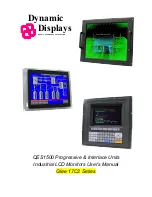
16
Chapter 4
Getting Started - Basic Operation
4.1
Introduction
The KPA101 K-Cube position aligner interfaces with the Detector Sensor Head and
can be used either to measure the position of the beam on the sensor or to generate
a signal that can be used as the feedback input for an automated be am steering
element (e.g. KPZ101 Piezo Driver K-Cube). The signal generated can be used to
steer the beam to the center of the position aligner sensor. This active feedback
system is particularly useful in beam stabilization applications.
Throughout this section, the sensor described is a PDQ80A quad detector. However,
the KPA101 unit is als o compatible with other Thorlabs detectors, such as the
PDQ30C IR detector head or the PDP90A Lateral Effect Detector.
4.1.1
Overview - Typical System Example
The system comprises a KP A101 position aligner K-Cube, a Sensor Head and two
KPZ101 Piezo Drive rs, together with th e associated piezo-actuated stage, turning
mirror and laser source (see Fig. 4.1). The objective of the system is to position and
hold the laser beam centrally within the detector array.
Fig. 4.1 Typical Stand Alone Set Up
The unit is first set to open loop mode. The turning mirror is adjusted manually to
position the laser beam within the detector array. The position aligner unit reads the
signal from the PDQ80A photodiode sensor to indicate the position of the beam on
the target display. When set to closed loop mode, the quadrant reader K-Cube sends
a pair of position demand signals to the piezo drivers, which control the position of the
piezo turning mirror.
HeNe
ASM003
Piezo Mount
Mirror Mount
KPZ101
KPZ101
KPA101
PDQ80A PSD Sensor
Beam Splitter
To Piezo Actuators
To Experiment
Position Aligner
MENU
Piezo Controller
MENU
Piezo Controller
MENU
















































